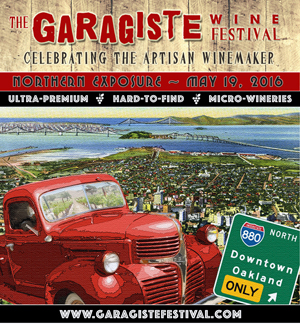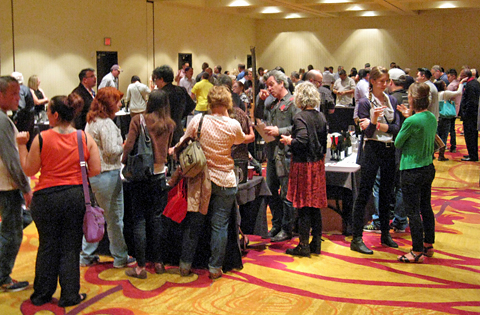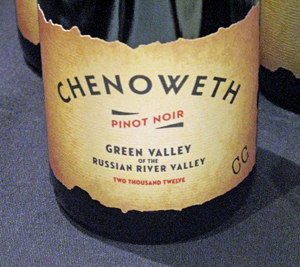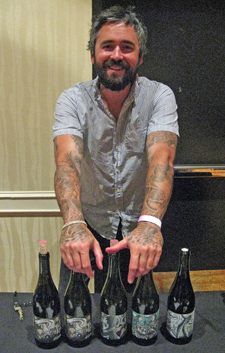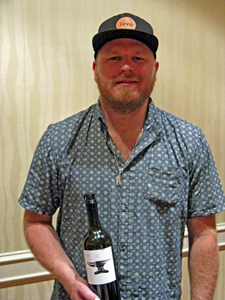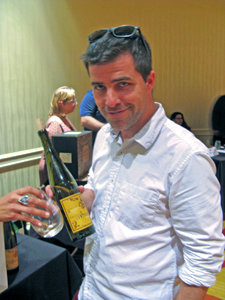Bodega de Edgar
Born in Michoacán, Mexico, proprietor Edgar Torres has lived on the Central Coast since he was a boy. He’s worked at the old Garretson Wine Company, McPrice Myers / Barrel 27, and at Hug Cellars – he now makes the Hug wines in addition to his own Bodega de Edgar label, which he launched in 2007. Edgar was behind his winery table at the tasting. Since I’d tasted a number of his wines just a few months earlier, I tasted just two newer releases this time – 2013 “El CabRhône” (50% Cabernet Sauvignon, 35% Syrah, 15% Grenache), and 2013 “Toro de Paso” (65% Tempranillo, 25% Grenache, 5% Cabernet Sauvignon, 5% Merlot). The “El CabRhône” blend featured plum and darker berry fruit, lots of spice, a touch of oak, and a fairly lively texture with moderate tannins. I thought the “Toro de Paso” was a standout, with savory dried herb/tobacco aromas along with plum, earth, and a hint of stony minerals, medium weight on the palate, and chewy tannins on the finish – this should improve with time in the cellar but it’s certainly tasty now. Edgar makes some interesting blends that are a bit different from most coming from Paso Robles.
Chenoweth Wines
Charlie Chenoweth is one of the best-known viticulturists in Sonoma County, working with noted producers such as Kosta Browne, Cirq, Patz & Hall, and many others. His family has lived in the Sebastopol area since the mid-1800s. Charlie and his wife Amy launched their label with the 2010 vintage, and they produce just one wine – a Pinot Noir – each year. Charlie farms the three vineyard sites that provide fruit for the wine – Chenoweth Home Ranch, Bootleggers, and Treehouse vineyards, all in the cool Green Valley of Russian River Valley. Their first vintage was in 2010. I tasted one wine at the Chenoweth table – 2012 Pinot Noir. Made from seven Pinot clones and aged in 33% new French oak, this showed ripe red fruit, spice, and sweet oak on the nose, with a lively and moderately rich texture and fine tannins – a polished wine that should appeal to fans of the Kosta Browne style.
Cutruzzola Vineyards
Frank Cutruzzola and Lisa Miller are the proprietors of Cutruzzola Vineyards. Their estate Riven Rock Vineyard is one of the cooler-climate vineyard sites in California, just a few miles from the coast near Cambria in San Luis Obispo County. The site was planted in 2001 and 2006 to Riesling and Pinot Noir, and noted Central Coast vintner Stephen Dooley of Stephen Ross Cellars makes the Cutruzzola wines. Frank poured me four wines at the tasting – 2013 “Gloria” Estate Pinot Noir, 2013 “Giacomino Reserve” Estate Pinot Noir (pre-release), 2012 Estate Riesling, and 2014 Estate Riesling. The “Gloria” Pinot displayed bright cherry fruit, earth, and spice, quite pleasant. The “Giacomino Reserve” bottling, which received longer barrel aging in more new oak, was even better, with a similar profile to the previous wine but greater intensity as well as more savory herb notes and a more structured mouthfeel and finish – this should age nicely. The 2012 Riesling was made in stainless steel with no malolactic fermentation – it was an off-dry style, with aromas of stone fruit, petrol, and touches of flowers and honey, with a lively texture, very appealing. The 2014 Riesling was in a drier style, and showed less petrol character with more apple, citrus, and orangepeel notes, with vibrant acidity – good potential for improving with time in the cellar. Four nice cool-climate wines from a producer that was entirely new to me.
Dilecta Wines
Orion Stang is the owner/winemaker of Dilecta. He grew up on the Central Coast, and he’s worked with noted vintners Eric Jensen at Booker Vineyard and with Scott Hawley at Law Estate Wines. Orion established Dilecta in 2011 – he made just two bottlings in 2011 and 2012 but he’s increased that to five for 2013. He was on hand at the Garagiste tasting and he poured me all five of his latest wines – 2013 “Match” (53% Syrah, 31% Grenache, 16% Mourvèdre), 2013 “Shadow Canyon” (100% Syrah), 2013 “Unorthodox” (100% Syrah), 2013 “The Tiller” (86% Syrah, 14% Grenache), and 2013 Bien Nacido Vineyard Syrah. All of the wines were aged two years in barrel. Fruit for the “Match” blend was sourced from three Westside Paso Robles vineyards – bright, ripe, and spicy, with both red and black fruit components, this finished with moderate tannins. “Shadow Canyon” – from the well-known vineyard in the York Mountain region – was a standout, with dark berry fruit, black olive, herb, pepper, and chocolate aromas. “Unorthodox” has been a GSM blend in past vintages but the 2013 is 100% Syrah, mostly from Paso’s Caliza Vineyard as well as Kimsey and Bien Nacido vineyards in Santa Barbara County. This showed a black fruit profile with spice and sweet oak notes, with a richer texture and chalky tannins. “The Tiller” was mostly sourced from Kimsey Vineyard in Ballard Canyon and had aromas of blackberry, earth, spice, plus some meaty undertones plus a grippy tannic finish. The Bien Nacido Syrah was savory and herbal with dark fruit, pepper, and spice on the nose, moderately rich yet lively with broad tannins – good potential for aging. Very good group of wines from Dilecta.
Flywheel Wines
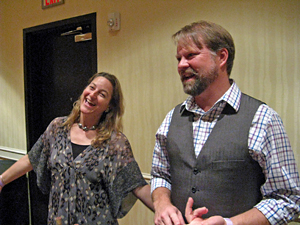 |
Scott Shapley and Laura Hoover launched their Flywheel with the 2012 vintage. Scott has worked at Siduri / Novy Wines and at Roessler Cellars among others, and he’s currently the winemaker for Roar Wines in San Francisco. Vineyard sources are mostly from the Chalone AVA in Monterey County, known for its limestone soil, and Flywheel has focused on Chardonnay, Pinot Noir, Grenache, and Mourvèdre. (Disclosure – I’ve helped out at Flywheel with bottling their wines). Both Scott and Laura were on hand, and they poured me five of their current releases – 2014 Rosé, 2013 Brosseau Vineyard Chardonnay, 2013 Brosseau Vineyard Pinot Noir, 2013 Boer Vineyard Grenache, and 2013 Boer Vineyard Mourvèdre. The Rosé is made from Pinot Noir fruit, and it featured subtle strawberry and earth notes on the nose, with a fairly smooth mouthfeel and finish. The Chardonnays and Rhône varieties are made in neutral oak, while there’s about 25% new French oak on the Pinot. The Chardonnay was a highlight, with bright citrus and lemon zest aromas, earth and herbs, and a lively, chalky texture. The Pinot Noir was also very good, with slightly tart red fruit and spice, a juicy mouthfeel and moderate, chalky tannins on the finish. Of the two Rhône-variety wines, I preferred the earthy and plummy Mourvèdre, with hints of orangepeel and spice, finishing with chalky tannins (that chalky character is common with wines from Chalone-area fruit) – still on the young side, it should develop nicely with time in the cellar. The Flywheel wines demonstrate how distinctive the Chalone growing region really is.
Halcón Vineyards
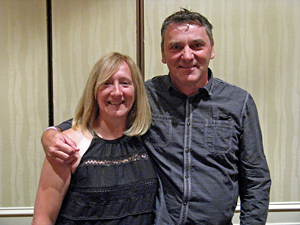 |
Halcón proprietors Paul and Jackie Gordon were behind their winery table at the tasting. Paul planted the vineyard, at nearly 2,500 feet in elevation, in the Yorkville Highlands area of Mendocino County in 2005. The vineyard is planted mostly to Syrah, with some Grenache, Mourvèdre, and a little Viognier. Their first vintage came in 2009, and Paul works with Scott Shapley in San Francisco to make the wines. (Disclosure – I’ve helped out at Halcón with bottling their wines). I tasted five Halcón wines – 2013 “Prado” (50% each Marsanne and Roussanne), 2014 Wentzel Vineyard Pinot Noir, 2014 Oppenlander Vineyard Pinot Noir, 2014 “Alturas” Estate Syrah, and 2014 “Tierra” Theopolis Vineyard Petite Sirah. The “Prado” blend, sourced from Alder Springs Vineyard, displayed floral and herbal notes along with melon, pear, and a touch of vanilla/oak, with a fairly smooth texture. All the reds were fermented with about 35% whole clusters and aged in 20-25% new French oak. The Wentzel Vineyard Pinot, from a site in Anderson Valley, showed upfront red fruit with notes of earth and spice, while the Oppenlander Vineyard bottling, from a remote site near the small town of Comptche, featured an earthier profile along with tea leaf and exotic spices on the nose plus black cherry fruit and more structure on the palate – this was a standout. The “Alturas” Syrah was another highlight, with plum and darker berry fruit, spice, touches of leather and earth, undertones of sweet oak, and fine acidity with a firm tannic structure – needs more time but has good potential. Sourced from Theopolis Vineyard, not far from the Halcón estate site, the “Tierra” Petite Sirah had black fruit and spice on the nose, full-bodied with a chewy tannic finish. Nice wines from an up-and-coming Mendocino County producer.
Levo Wines
Levo owner and winemaker Bret Urness and his friend Jamie Traylor started their label in 2011, with the first releases coming from the 2012 vintage. The focus is on blends of Rhône grape varieties. Although Bret makes his wines in Paso Robles’ Tin City complex, nearly all of his fruit sources are in Santa Barbara County, mostly in the Ballard Canyon and Los Alamos areas. Bret poured me three of his wines at the tasting – 2013 “Mint” (96% Syrah, 4% Grenache), 2013 “The Heavy” (88% Petite Sirah, 8% Syrah, 4% Grenache), and 2014 “Volts” (41% Roussanne, 31% Grenache Blanc, 28% Viognier). We started with “Mint,” which was my favorite of the Levo wines I tried. Sourced from White Hawk, Stolpman, Kimsey, and Thompson vineyards, fermented with 20% whole clusters and aged in 100% new French oak, this had savory aromas of grilled meat, olives, herbs, blackberries, all framed by sweet oak, with a fairly rich texture and broad tannins. Next was “The Heavy,” and true to its name, this was the biggest wine I tried at the entire tasting – from Stolpman and Kimsey vineyards and aged in 100% new French oak, this featured ripe and intense dark fruit, mocha, and spice, full body and a huge, grippy tannic finish. Finishing on a lighter note, “Volts,” from Stolpman, Thompson, and Murmur vineyards and aged in 1/3 each new and neutral oak plus stainless steel, this showed ripe stone fruit, lees, and spice on the nose, with a rich mouthfeel and finish. Even though Levo’s fruit sources are from Santa Barbara, these well-made wines are solidly in the bigger “Paso style”.
Maidenstoen Wine
Mike Callahan is the man behind Maidenstoen Wine. He established the label in 2013 and specializes in Riesling from the Central Coast. In addition to the three vineyard-designate bottlings I tried at the tasting, he’s also made one from Lafond Vineyard in Sta. Rita Hills. I tasted three wines with Mike – 2015 Tondré Grapefield Riesling, 2014 Coastview Vineyard Riesling, and 2014 Zabala Vineyard Riesling. All three bottlings come from Monterey County fruit. The Tondré bottling displayed stone fruit and spice aromas, with nice acidity, and a fairly dry and slightly chalky finish (less than 1g/L residual sugar). The Coastview Riesling was made in stainless steel drums and had more petrol and floral notes, with vibrant acidity along with a slightly richer mouthfeel than the previous wine and just off-dry finish. With floral, citrus, and herb aromas, the Zabala bottling was the driest of the three and had a zippy texture and lip-smacking finish. All three of these were very good and distinctive renditions of Riesling, and the Coastview and Zabala bottlings were my favorites of the three. If you’re a fan of the “new” California Rieslings, Maidenstoen looks like a producer to watch.
MCV Wines
MCV was launched in 2011 by winemaker Matt Villard – MCV are his initials. He worked at Quintessa in Napa and Justin in Paso Robles before starting his own label. Matt specializes in Petite Sirah and Petite-based blends from Paso Robles but he’s also starting to branch out into other grape varieties. Matt poured me four of his latest releases at the tasting – 2013 “Red” (Petite Sirah, Syrah, Grenache, Tannat, Petit Verdot), 2013 Syrah, the 2013 “1105” (59% Petite Sirah, 15% Syrah, 14% Tannat, 7% Petit Verdot, 4% Grenache, 1% Viognier), and 2013 “Black” (73% Petite Sirah, 18% Tannat, 9% Petit Verdot). The “Red” blend was spicy and plummy, with medium body and moderate tannins – the most forward of the four MCV wines. Sourced from Glenrose and Starr Ranch vineyards, the Syrah showed a darker fruit profile plus mocha, spice, and earth components, medium-full bodied with more structure on the palate. The “1105” blend (think of “MCV” as Roman numerals) displayed riper and more intense blueberry aromas along with hints of chocolate and smoke – richer mouthfeel with broad tannins, an interesting blend that could develop nicely over the next few years. The biggest of the wines, the “Black,” was dense and dark, with ripe fruit, undertones of flowers, spice, and sweet oak, with full body and a grippier tannic finish. Some bigger “Paso style” wines that are unusual in their focus on Petite Sirah.
|
Murder Ridge Winery
 |
Murder Ridge proprietors Leslie Sisneros and Steve Alden welcomed me to their table at the tasting. Leslie has been the winemaker for several noted Sonoma County producers over the years including Chateau St. Jean, Rodney Strong, and Arista. Steve owns Perli Vineyard in the remote Mendocino Ridge AVA between Anderson Valley and the Pacific coast. The area is particularly known for Zinfandel and Pinot Noir, and those varieties are the focus at Murder Ridge. I tasted three wines at the table – 2014 Perli Vineyard Pinot Noir, 2014 Perli Vineyard Zinfandel, and 2014 “Wildlands” Zinfandel. Made in 33% new French oak, the Pinot showed bright cherry fruit, floral and spice notes, and a touch of sweet oak, with medium weight on the palate and a lively finish. The Perli Zin had lots of savory herbal aromas along with plum and boysenberry fruit, earth, with undertones of pepper and spice, a structured mouthfeel and moderately tannic finish – tasty now but should develop well with a few years of cellaring. Sourced from Perli and Fashauer vineyards, the “Wildlands” Zinfandel showed similar character to the Perli bottling, with perhaps a bit more upfront fruit but a little tighter with more grip on the finish – shows good potential but it will probably take more time to unwind. Murder Ridge is working with some distinctive Mendocino Ridge fruit, and it should be worth watching this newer producer.
Ryan Cochrane Wines
Ryan Cochrane launched his winery with the 2010 vintage, when he produced less than 25 cases of Pinot Noir. After working at a San Francisco advertising agency, he made a career change to winemaking, working with Roger Nicolas at RN Estate in Paso Robles in 2009. Ryan sources his fruit from Solomon Hills Vineyard in Santa Maria Valley and Fiddlestix Vineyard in Sta. Rita Hills, though he makes his wines in San Francisco. Ryan poured me four wines at the event – 2013 Solomon Hills Vineyard Chardonnay, 2014 Solomon Hills Vineyard Chardonnay, 2013 Solomon Hills Vineyard Pinot Noir, and 2012 Solomon Hills Vineyard Pinot Noir. The 2013 Chardonnay was a highlight – made in 40% new French oak, it displayed tropical fruit and pear aromas plus touches of spice, vanilla, and a hint of salinity, a moderately creamy mouthfeel and a long, elegant finish. The 2014 vintage, with a bit less new oak, was similar but was a bit riper and richer in character. Both Chardonnays were entirely from Clone 4. The 2013 Pinot Noir, from 115, 667, and Pommard clones and fermented with 25% whole clusters and aged in 20% new French oak, featured black cherry fruit supported by tea leaf, spice, and forest floor scents plus a touch of orangepeel, with a lively mouthfeel and fine tannins – one of the tasting’s standout Pinots. The 2012 vintage, from 115 and Pommard clones with 33% whole-cluster fermentation, had higher-toned fruit notes along with touches of flowers and herbs, with more structure on the palate and finish than the previous wine. Ryan also was pouring three Pinot Noirs from Fiddlestix Vineyard but I opted to give those a try at a later date – hopefully soon. I’ve been impressed both times I’ve tasted the Ryan Cochrane wines.
Tercero Wines
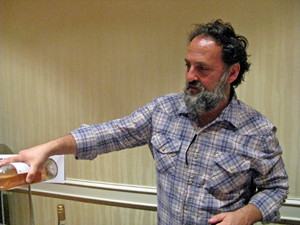 |
Larry Schaffer started his Tercero label with the 2006 vintage while he was working for Fess Parker Winery – he’s focused on Tercero full-time since 2011. His specialty is wines from Rhône grape varieties sourced from Santa Barbara County vineyards, though he makes a very nice Gewürztraminer and Albariño as well. As usual, Larry had loads of wines at his table, and I picked out a few to taste…at least I though it was just a few but it turned out to be eight of them – 2014 Grenache Blanc, 2014 “Verbiage Blanc” (64% Roussanne, 24% Viognier, 12% Grenache Blanc), 2013 Roussanne, 2015 Mourvèdre Rosé, 2015 “aberration” (40% Cinsault, 40% Grenache, 20% Mourvèdre), 2012 Mourvèdre, 2011 “Verbiage Rouge” (38% Grenache, 38% Syrah, 12% Mourvèdre, 12% Viognier), and 2011 Larner Vineyard Grenache. Larry uses stainless steel and neutral oak for fermenting and aging his white wines. With reds, he’s worked extensively with Grenache and increasingly with Mourvèdre, and he’s used more whole-cluster fermentations in recent years and ages the wines in older barrels. While the richer “Verbiage Blanc” and Roussanne bottlings featured pear and stone fruit aromas – with an intriguing lemonpeel note on the Roussanne – the Grenache Blanc was my favorite of the three whites. Sourced from 50% each Camp 4 and El Camino Real vineyards, it displayed pear and apple fruit, petrol, and a touch of fresh herbs, with a mildly chalky texture, lively acidity, and clean finish. The Mourvèdre Rosé was a highlight – sourced from Vogelzang Vineyard in Happy Canyon, this had floral strawberry and spice scents on the nose, with juicy acidity and a slight tannic bite on the finish. The “aberration” blend is a new one for Tercero – the fruit was fermented entirely with whole clusters and aged in stainless steel drums. Fresh black cherry and floral aromas along with earth and herbs, a bright and lively texture, and milder tannins, should be a terrific lighter red for summertime. Of the other three reds, the bright, herbal and red-fruited Larner Vineyard Grenache was my favorite, though the other two (particularly the deep, earthy, and structured Mourvèdre) should reward some additional time in the cellar. Larry’s Tercero wines continue to be some of the best Rhône-style wines from Santa Barbara County.
Tessier Winery
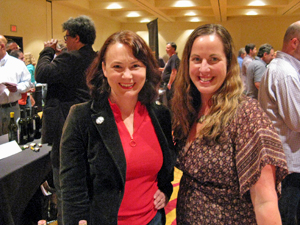 |
| Kristie Tacey with Megan Long |
Owner/winemaker Kristie Tacey started Tessier with the 2009 vintage. With a background as a research scientist, she began to work with a small urban East Bay winery in 2006 prior to establishing her own label. She specializes in Pinot Noir, Grenache, and Viognier, and she has started making Cabernet Franc as well. Kristie was on hand at the tasting, and she poured me four of her wines – 2013 Saveria Vineyard Pinot Noir, 2013 Morelli Lane Vineyard Pinot Noir, 2014 Fenaughty Vineyard Grenache, and 2015 Alegría Vineyard Cabernet Franc (barrel sample). Kristie uses about 20-30% new French oak for aging her Pinots, while the Grenache and Cab Franc are aged in neutral oak. From the Corralitos region of the Santa Cruz Mountains, the Saveria Vineyard Pinot Noir was a standout, with bright red fruit aromas, savory herbal notes, earth, and a light touch of sweet oak, with an elegant, lively texture and fine tannins. The Morelli Lane Pinot, from Russian River Valley, displayed black cherry and spice, with a somewhat richer mouthfeel and finish. Fenaughty Vineyard is at higher elevation in El Dorado County, and the Grenache was fermented entirely with whole clusters – this had strawberry and cherry, fresh herbs and a touch of pepper on the nose, with fine acidity and moderate tannins, another highlight wine. The Cab Franc barrel sample, from Russian River Valley, showed the varieties herbal character well, with black cherry and raspberry notes and a slight floral touch, vibrant mouthfeel and fine, chalky tannins – shows plenty of potential. An impressive group of wines from Kristie and Tessier.
the Central Coast Group Project
The Central Coast Group Project (or CCGP for short) is run by owner and winemaker Scott Sampler, who makes his wines in Santa Barbara County. Scott favors long extended macerations for his reds – some over 120 days. Taking care of the wines during such a lengthy time on the skins is a laborious process, developing the flavors and tannin structure that he’s looking for. I tasted two wines with Scott – 2012 “Barrington Hall Wine Dinner Special Cuvée” (36% Grenache, 33% Mourvèdre and 31% Syrah) and 2012 “Names” White Hawk Vineyard Syrah. The fruit for the “Barrington Hall” bottling came from Thompson and Larner Vineyards and the wine was aged in neutral oak. This wine featured bright red fruit, spice, with earth and dried herb undertones, lively acidity and moderate tannins – tasty now but has the structure to age. “Names” is an equal blend of clones 1, 174, and 877, including 5% Viognier and 30% whole-cluster fermentation – a darker and riper fruit profile with lots of spice plus earthy and floral notes, this had fine acidity with bigger structure and firmer tannins than the previous wine. Scott was also pouring his three “Variations on a Clone” bottlings of the “Names” clonal components, but I was short on time and passed on tasting them (I’ve tried them in the past and they’re quite good). Scott is making some very distinctive wines with CCGP – worth following his venture.
Theopolis Vineyards
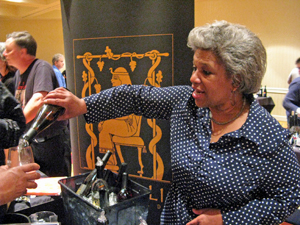 |
Theodora Lee is an attorney who also owns and farms her own vineyard in the Yorkville Highlands region of Mendocino County – her nickname is Theo-patra, Queen of the Vineyards! She planted her five-acre vineyard – all Petite Sirah – in 2003 and has sold fruit to producers including Carlisle, Halcón, and Highlawn. She began producing wine under her own label with the 2012 vintage and she’s now making it in San Francisco. Theodora poured me four of her wines – 2014 Symphony, 2014 Estate Rosé of Petite Sirah, 2014 Anderson Valley Pinot Noir, and 2013 Estate Petite Sirah. The Symphony – the grape variety is a cross between Muscat of Alexandria and Grenache Gris – was made in stainless steel and had lightly floral stone fruit and pear aromas plus a touch of spice, lively acidity and a dry, crisp finish, very distinctive and pleasant. It’s rare to see a rosé made from Petite Sirah – this one, made in neutral oak, showed cherry and plum with undertones of flowers and earth, with a fairly smooth texture and finish. The Pinot Noir was aged in 25% new French oak, and was quite savory and herbal on the nose, with black cherry and tea leaf aromas with a touch of spice, medium weight on the palate, and milder tannins. I’m not generally a big fan of Petite Sirah, but this one, also aged in 25% new French oak, was a standout. Floral and spicy, with plum and darker berry fruit and notes of mocha, pepper, and earth, this had bright acidity and fairly big, chewy tannins on the finish – a few years in the cellar should benefit this wine but it’s already appealing. Theodora is producing some solid wines for her Theopolis label, and it should be one to keep an eye on in the future.
West of Temperance
West of Temperance is the label of John King and Brian Ojalvo, both from Marin County. Brian has been the assistant winemaker for noted vintner Sean Thackrey. Their first West of Temperance wines were released in 2015, with fruit sourced from a number of vineyard sites, some from lesser-known growing regions in California such as Clarksburg, Hopland (in Mendocino), and Yolo County. I tried three wines at the tasting – 2012 Aglianico, 2013 Heringer Estates Vineyard Teroldego, and NV “Colorfield Vol. 1”. The Aglianico was sourced from two vineyards, and displayed plummy, earthy fruit with spice undertones and surprisingly tame tannins for this variety. The Teroldego fruit is from the Clarksburg AVA – it had red fruit and fresh herbs on the nose, with tea leaf and earth in the background, more structure than the previous wine and a moderately tannic finish. The “Colorfield Vol. 1” is a non-vintage wine combining fruit from the 2012, 2013, and 2014 vintages – it’s a blend of Petite Sirah, Aglianico, Teroldego, Pinot Noir, Sangiovese, Merlot, Viognier, and Zinfandel. This showed both red and black fruit aromas plus lots of spice, fairly smooth texture and round tannins. There were additional wines at the table but I passed in the interest of time – the Teroldego was my favorite of the three West of Temperance wines.
 |
|


